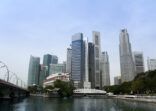Fixed income funds sold in Malaysia had net inflows of RM 6bn ($1.43bn) in the first half, according to data from Morningstar Direct.
On the flipside, equity funds saw sizable net outflows of RM 2.8bn during the same period.
Net inflows / outflows in H1 2020
| Global broad category | RM m |
| Mixed-asset | -13 |
| Equity | -2,836 |
| Fixed income | 6,034 |
Source: Morningstar Direct. Note: Data excludes money market funds and fund-of-funds.
Driving the inflows toward fixed income funds are conventional Malaysia bond funds, which had net inflows of RM 2.6bn, followed by shariah Malaysia fixed income funds, which attracted RM 1.7bn from investors. Both asset classes were also the two most popular fund categories among all mutual funds sold in the country, the data shows.
“The general sentiment among retail investors are pretty much conservative. Investors are also seeking stable yields in the domestic fixed income space,” Jaslyn Ong, Singapore-based analyst at Cerulli Associates, told FSA.
Meanwhile, shariah fixed income funds continue to be popular as investors consider them as safe haven investments when markets are volatile.
“Shariah investing is said to weather economic downturns. For example, shariah screening will remove companies with high leverages and keep those with good balance sheets,” Ong said.
Shariah-compliant investments are in line with basic Islamic principles. For example, no stocks may derive income from gambling, alcohol, tobacco, pork products, adult entertainment or military equipment. The principles also restrict the use of some mainstream financial instruments such as debt-financing, charging interest or the use of derivatives.
Thematic bets
While equity funds sold in Malaysia were generally avoided, those that invest in global equities, as well as global themes had net inflows in the first half.
Global equity funds attracted RM 650m during the period, while sector equity funds had net inflows of RM 422m, Morningstar Direct data shows.
“Flows into global equities and thematic equities, such as technology and healthcare, have been relatively strong,” Cerulli’s Ong said.
“For the technology funds and some global equity funds, their underlying holdings are in the large conglomerates like Apple, Microsoft, Alibaba and Tencent, and these companies have performed well with the increased digital adoption during the lockdown periods,” she explained.
Among the different thematic funds offered in Malaysia, TA Investment Management’s TA Global Technology Fund attracted the most assets, with inflows of RM 298m, followed by Affin Hwang Asset Management’s World Series Global Healthscience Fund, which attracted RM 207m, according to Morningstar Direct.
Public Mutual’s Lifestyle & Technology Fund and Principal Asset Management’s Global Technology Fund also each had inflows of at least RM 100m during the first half.
Both the TA and Affin Hwang products are feeder funds. The TA Global Technology Fund is the white-labelled version of the Janus Henderson Horizon Horizon Fund – Global Technology Fund, while the Affin Hwang’s Global Healthscience Fund invests in Blackrock’s BGF World Healthscience Fund, according to their fund factsheets.
Meanwhile, both the Principal AM and Public Mutual offerings are domiciled locally.
Public Mutual, Principal AM and Affin Hwang AM are also the three largest fund managers in Malaysia, with Public Mutual accounting for nearly 50% of the country’s fund industry, excluding money market funds, Morningstar Direct data shows.
Top three largest fund managers in Thailand (RM bn)
| AUM | Market share | |
| Public Mutual | 79 | 47.22% |
| Principal AM | 22 | 13.16% |
| Affin Hwang AM | 17 | 9.92% |
Source: Morningstar Direct. Note: Data excludes money market funds and fund-of-funds.
China equity funds avoided
On the flipside, domestic equity and Asia-Pacific (ex-Japan) equity funds had the largest outflows among all mutual fund categories in Malaysia, Morningstar data shows.
Mutual fund categories with the largest outflows in Malaysia in H1 (RM m)
| Name | YTD |
| Equity – Asia Pacific (ex-Japan) | (879) |
| Equity – Malaysia Large-cap | (867) |
| Equity – Malaysia Large-cap (Sharia) | (792) |
| Equity – Malaysia Income | (541) |
| Equity – Greater China | (387) |
Source: Morningstar Direct. Note: Data excludes money market funds and fund-of-funds.
Greater China funds were also avoided during the first half despite the relative outperformance of the asset class compared to its regional and global peers.
Cerulli’s Ong noted that there were inflows into Greater China equities in April when China’s economy was beginning to reopen while other nations were still on a lockdown state.
However, interest was subdued due to the ongoing geopolitical tensions with the US and the pandemic, she explained.
Not all China equity funds had net outflows during the period, however. For example, Public Mutual’s Greater China A-Shares Fund, which was rolled out in March, has continued to receive sizable inflows since its launch, Ong said. The fund, which invests at least 50% of its assets in China A-shares, had net inflows of RM 201m during the first half, according to Morningstar data.

















